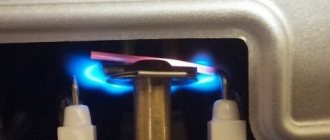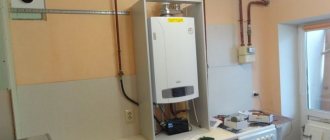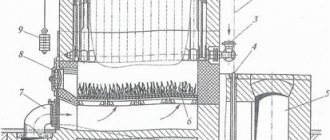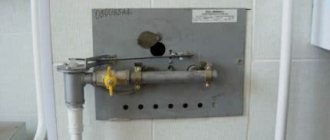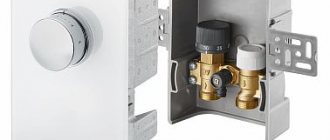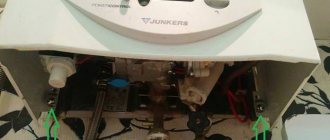What influences the choice of a specific device
Gas, for all its convenience and the amount of energy released during combustion, has a key feature. This is a dangerous fuel. Each gas-powered device, for example, a storage water heater or a water heater, must be installed and operated in compliance with certain rules, and have clearly marked safety systems. The choice of a particular unit may be influenced by:
- gas pressure indicators in the supply line;
- the type of gas supplied to the device;
- the ability to use coolant prepared by an external installation;
- the presence of interruptions in supply or insufficient pressure parameters to start the installation.
You should choose a storage water heater, geyser or combined device by carefully analyzing the capabilities and potential emergency situations.
Design and principle of operation
The basic structure of all geysers is the same. A flow-through heater consists of a housing, a water and gas unit, a heat exchanger, a combustion chamber, sensors, a control unit, and a chimney. For turbocharged devices, only a fan is added. The general principle of operation is also the same: water extraction begins - the burner lights up, the water tap is closed - the flame goes out.
If we go into the nuances of the operation of a turbine column, they are very different from the functionality of a traditional device:
- While there is no water analysis, air is not forced into the closed combustion chamber. The pilot light does not light because it is missing.
- When water collection begins, the water and gas unit is activated. The mechanism opens the valve through which gas enters the burner. The controller gives a command for electrical ignition and a spark appears on the electrodes. The sensor informs about the appearance of a flame on the burner. It gives a signal to the controller to stop sparking.
- When the column is ignited, the fan turns on. It begins to pump air from the street into the chamber and at the same time remove combustion products through a coaxial chimney.
- The water is heated to the set temperature. This indicator is monitored by a sensor connected to the controller. With an increase or decrease in water flow, the modulating burner switches combustion intensity levels, thereby maintaining the set temperature.
- As soon as the water flow stops, the burner and fan turn off. The speaker goes into standby mode.
With the start of a new water collection, the entire cycle repeats.
Efficiency of a turbocharged water heater
A fan installed in a gas water heater, a modular burner and a double-walled coaxial chimney can increase efficiency up to 90%. The column developers managed to achieve the efficiency of the device due to three parameters:
- the fuel mixture is prepared from a precise ratio of gas to air;
- stepwise combustion adjustment saves gas, preventing overheating of water with little analysis;
- Inside the coaxial pipe, preheating of the incoming air flow occurs.
The increase in efficiency is more influenced by the third parameter. The air entering from the street warms up against the walls of the coaxial chimney. Cold does not get inside the chamber, due to which less gas is spent heating the water in the heat exchanger.
Safety stages of a chimneyless dispenser
When considering the operation of a water heater with a turbo hood, it is worth paying attention to the safety levels. The protection is triggered according to the following parameters:
- there is no draft in the hood due to the fan stopping;
- the flame on the burner has disappeared;
- high or low gas pressure in the supply pipeline;
- low or high pressure in the water supply;
- heating the heat exchanger to a critical temperature;
- low water consumption;
- controller failure.
If one of the problems occurs, the operation of the geyser will stop.
Excellent choice for centralized feeding systems
Gas water heater built into the kitchen cabinet
If a mains line from a centralized supply system is connected to the house, a direct heating gas boiler, a well-known water heater, can be an excellent choice. Such a device is capable of:
- directly during selection, raise the water temperature by a significant amount;
- ensure safe operation;
- guarantee (when choosing the appropriate power model) operation at existing gas pressure parameters;
- meet the hot water needs of a large family.
The gas water heater operates according to a simple scheme. When water is withdrawn, the gas is automatically ignited. The burner transfers energy to a heat exchanger, which raises the temperature of the liquid passing along the route from the tubes. The following common engineering solutions exist:
- gas boilers with an open combustion chamber. This column segment is considered obsolete. Their installation must be carried out in a thoroughly ventilated room with sufficient access to oxygen; a chimney with good draft is necessary;
- geysers with a closed combustion chamber. A technological device that does not require the presence of a chimney, it operates on the principle of taking air from outside the house and releasing exhaust gases through a coaxial or combined outlet. This type of direct heating gas boiler is equipped with turbines to ensure efficient operation.
Modern models of dispensers with a closed combustion chamber can be installed in ordinary premises after assessing the quality of the chimney by regulatory authorities. Outdated boilers, especially those of high power, must be installed in specially designated places, boiler rooms or utility rooms, where a sufficient flow of oxygen is ensured.
Operating principle of a storage water heater
The principle of operation of the boiler is based on the natural separation of cold and hot layers of water. Due to its lower density, hot water rises to the top, while cold water remains at the bottom. Let us describe in more detail the operating principle of the water heater.
Water heating is provided not only by the burner, but also by removing combustion products. The chimney is designed in such a way that the smoke is evenly distributed throughout the steel pipe, its walls heat up and exchange heat with water. The operation of the burner is controlled by an electrical element, which, when a certain temperature in the tank is reached, turns off the burner.
As soon as the consumer begins to consume hot water from the tank, the pressure inside it drops and cold water rushes into the tank from the water supply. A divider is installed on the supply tube, which reduces the water flow and its speed by dividing one large flow into many smaller ones. Thus, the cold water remains below exactly where the burner is installed. The electronic unit is activated when the water in the tank cools and turns on the burner. This is exactly how a gas water heater works in normal mode.
Storage boiler
Storage boiler capacity
In places where gas pressure is insufficient for efficient operation of direct heat transfer devices, a gas storage heater is used. The operating diagram of such a device is as follows:
- water is supplied to a large container;
- gas burners located below act on the bottom of the tank, carrying out heat transfer;
- combustion products are discharged through a pipe laid inside the tank, providing additional heating.
Similar to geysers, a storage water heater can have either an open or closed combustion chamber. Accordingly, a gas boiler of this type is installed.
The undoubted advantages of the storage installation include the smoothness of the temperature rise. A boiler of this class does not require intensive heat transfer. It can operate at low pressure parameters in the supply system, as well as from gas tanks and cylinders where the gas is in a liquid state.
Another advantage that a gas storage boiler has is its efficiency. The water tank is surrounded by a layer of thermal insulation, so the temperature drops slowly. Boilers with a significant volume have the highest efficiency indicators. They dampen intensive water extraction well - the temperature changes little when filling a bathroom, for example.
Important! The energy efficiency of a storage-type gas boiler depends on the presence of automatic control systems. Self-controlled ignition, monitoring water temperature, presence of flame - the required minimum of control tools.
How does a gas storage water heater work?
A gas boiler consists of a steel (or plastic) body and an internal storage tank. The internal tank is usually coated with a special coating or enamel that is resistant to corrosion. There is a small space between the outer casing and the inner tank, which is filled with thermal insulation material. Most often this is polyurethane foam .
Inside the tank there are tubes for supplying and draining water. The longest outlet tube reaches the hottest water layer. The supply tube is equipped with a divider to prevent cold layers from mixing with hot ones.
The heating part of the boiler consists of a thermostat, a gas burner, and a gas duct connected to it with a smoke diffuser. The structure of a gas boiler is clearly shown in the figure.
A safety valve is a necessary and mandatory part in every storage water heater. With its help, excess pressure inside the boiler is released, as well as excess water formed during the expansion of the liquid when heated.
Combination boiler
Combined installation
In places where the gas supply may be temporarily interrupted or in the presence, for example, of a solid fuel heating boiler, a combined heating installation shows good results. It consists of two circuits:
- a direct heating gas boiler, the task of which is to ensure the temperature of the water during its intensive selection;
- an indirect heating boiler, the heat source of which is the liquid supplied by the main heating boiler or the exhaust gases generated during its operation.
Combined heating systems show significant cost savings. It is rational to use them if there is a sufficient supply of boiler power in the heating system. With a significant capacity, they are able to meet the hot water needs of a large family even without starting a direct heating circuit. Also, if the gas supply is interrupted, the combined boiler will perform its functions using the energy of the heating system.
Types of gas water heaters
Water heating devices that use natural gas as energy resources are divided into only two types depending on the method of heating the liquid:
- storage gas water heaters;
- flow-type devices operating on gas.
I would like to note that the choice of a water heating device model should be based on the following characteristics of gas equipment:
- Volume of water consumption. If the heating device will be used by several residents of an apartment or house at once, then the liquid that fits into the tank of the storage device is not always enough.
- Parameters of the central cold water supply. Experts do not recommend buying flow-through gas water heating devices if the pressure parameters in the central water supply are very low.
- Installation features - the water tank in the storage device is large and therefore requires a suitable location on the floor or a solid wall.
Not so long ago, geysers were considered inconvenient to use, since in order to obtain heated water it was necessary to open the gas supply tap, bring a lit match to the burner, or press inconvenient buttons. But technology does not stand still and modern models of water heaters have become more functional and easy to use.
Therefore, in the process of choosing a gas water heater, you need to pay special attention to the ignition method installed in a particular device model. Today, there are only three methods for turning on a gas water heater:
- Ignition of the column using a piezoelectric element. To put the device into working condition, the user must press a special button.
- The electric ignition system does not have a constantly burning igniter, which, although slowly, consumes gas. In such a device, the switching occurs automatically as soon as the hot water supply valve is opened.
- Modern Hydropower ignition system. When the hot water valve opens, its flow sets in motion a special turbine, which generates a current sufficient to ignite the burner.
Security systems
The safety group protects against overheating.
Gas is a high-energy, dangerous fuel. Installation of gas equipment must be carried out in strict compliance with the requirements of the relevant control authorities. To ensure operational safety, it is necessary to choose a model equipped with a certain list of automatic regulation and control devices.
- For direct-heated gas boilers, the key systems are pressure control in the supply line, overheating protection, and steam release valves. The presence of a sensor that stops dry operation is welcome.
- For storage-type gas boilers, in addition to the listed means, modes that set operating parameters in different seasons (summer, winter) are necessary. Safety systems are complemented by valves and sensors designed to control the liquid in the tank. These are systems for resetting, diagnosing pressure indicators, and preventing boiling.
- Combined type boilers must have the systems listed above. The best models can monitor the parameters of the coolant or gases coming from the main heating boiler, and also exchange data with its control systems.
It is impossible to imagine a modern gas boiler without a certain list of required systems. This is automatic ignition, monitoring the presence of flame. For models with a closed combustion chamber and equipped with a turbine, it is necessary to control the operation of the fans responsible for supplying air to the firebox and removing exhaust gases.
Operational safety
Storage water heater 50 liters
Any gas equipment represents a source of increased fire hazard. The safety of operation of gas “storages” is ensured as follows:
- If the flame in the ignition device goes out, the temperature sensor cools down, the current in the circuit is interrupted, which causes the valve to close.
- A closed valve interrupts the gas supply to the burner.
- The water heater is also equipped with automatic control of the flame on the igniter and the draft in the chimney. In the absence of flame or draft, the automatic shuts off the gas supply to the firebox.
Where and how to place a gas boiler
Gas heater with a closed combustion chamber
A gas boiler should be installed based on its design, weight, dimensions, and requirements of regulatory organizations. It is strictly recommended to place devices with an open combustion chamber in specially designated rooms: boiler rooms, utility rooms. The boiler will require a chimney and sufficient ventilation to supply oxygen.
Modern devices with a closed combustion chamber can be installed in ordinary premises, provided that the coaxial or combined chimney is led outside the building. Such installations are quite safe; with modern means of control, they do not harm human health and well-being, since they do not take oxygen from the room or emit combustion products into its volume.
Wall-mounted boilers must be installed in compliance with the requirements of regulatory authorities. Their list includes the distance to the nearest heat source, vertical elements of the gas supply route, and the meter. Before installation, a project is drawn up, which must be approved by the gas industry. Floor-standing boilers are located on a reliable foundation; in private houses it is not recommended to install such installations on the second or third floor of the building.
The most difficult situation is with combined gas boilers. Their purchase and installation should be made taking into account the following factors:
- It is advisable that the heating boiler and boiler be from the same manufacturer, since products of a single brand will not necessarily be compatible with the equipment of another.
- The boiler power consumption level should not exceed the heating system reserve. Failure to comply with this requirement can lead to troubles and malfunctions in the operation of the main boiler.
- If the house uses a low-temperature heating system, for example, underfloor heating, a combined condensing type boiler will be required.
The listed requirements are known to manufacturers of water treatment systems. A good certified combination boiler will definitely have information in the documentation about which brands of equipment it is compatible with. The instructions will also contain recommendations for heating boiler parameters and other useful information.
The principle of operation of a chimneyless column
A gas water heater that is not equipped with a chimney allows water to be heated using the energy generated by gas combustion. The heated water can later be used for any purpose - hot water supply has a lot of functions. To operate the device, you can use both main and bottled gas.
A characteristic feature of chimneyless devices is the method of removing combustion products. The combustion chamber in such water heaters is hermetically sealed, and a coaxial chimney is used to remove exhaust gases, which is vented outside through the wall. Removal of combustion products is carried out by a fan, originally built into the heater. The supply of oxygen necessary for combustion is carried out through the external part of the chimney.
Due to its design, a geyser without a chimney is ideal for rooms that do not have a chimney. To ensure the connection of the device with the atmosphere, you just need to make a hole in the wall and insert a coaxial chimney into it.
A positive aspect associated with the use of flueless heaters is the fact that they do not burn oxygen in the room and do not require forced air intake from the street. In addition, you can save a lot of money on the installation of such devices - a traditional full-fledged chimney is very expensive, and there are many difficulties when installing it.
When choosing a chimneyless gas water heater, you need to pay attention to several characteristics:
- Gas water heater power;
- Correspondence of power to the specific operating conditions of the device;
- Water heater performance;
- Type of burner and ignition;
- Degree of security.
Using the services of a specialist is necessary
Only a specialist guarantees the safety of the connection.
Gas equipment is prohibited from installing, connecting, or starting up by persons who do not have the appropriate qualification certificate. Therefore, hiring a company or specialist is necessary. The list of required documents includes a project, permits from the gas service, and certificates of chimney inspection.
The easiest job is to replace, for example, an old water heater or boiler. For operations in a new house or the organization of additional structures (gas supply, coolant routes, equipment piping) - obtaining all permits will take a lot of time. The preparation of documents and procedures for their approval by regulatory authorities should also be entrusted to specialists.
Boiler advantages
This design has many advantages compared to other coolant heating sources. A large number of consumers can be connected to the storage tank. A geyser is not capable of simultaneously providing hot water to several points at once, since the water pressure will drop and its temperature will increase.
If the boiler is heated gradually, the gas consumption will be significantly lower than that of a flow-through heater. It is possible to heat water in such equipment to a high temperature, since almost all models are equipped with a system for its regulation.
In addition, in order to save fuel consumption, the user can control the temperature settings. The thermal insulation built into the design allows you to maintain a high temperature of the coolant for a long time. Unlike a gas water heater, the boiler is capable of operating at low pressure of cold water in the system.
The amount of combustion products during operation of a storage water heater is much less than when heating water with a column. Because of this, its chimney diameter is only 90 cm. This figure for a flow-through heater is 130 cm.
Gas water heaters: pros and cons
The biggest and main advantage of units of this type is the ability to provide the house with hot water for an unlimited time. The burner of the device begins to heat the water almost immediately after opening the tap and will do this until the valve closes. This feature of geysers makes them the undoubted leader among all units in terms of comfort.
The only condition: the thermal power of the burner must be enough for all consumers. Modern turbocharged units are equipped with electronic combustion intensity control systems, as a result of which changes in water pressure have virtually no effect on its final temperature. But if the thermal power of the gas water heater is initially selected incorrectly, then at high flow rates barely warm water will flow from all the mixers.
An important advantage of gas instantaneous heaters is their small dimensions, allowing the device to be squeezed into the smallest kitchen. Thanks to this, speakers are so popular among residents of small apartments
In addition, the product is quite reliable (if you do not take into account Chinese products) and repairable. Due to the fact that water supply networks in the post-Soviet space leave much to be desired, the gas water heater periodically requires maintenance and cleaning
Now about the disadvantages:
- Installation of gas-using equipment is a troublesome task and requires investment. You need to complete the project, get it approved, and then install and connect the heater, which only a licensed organization has the right to do;
- any gas water heater requires a chimney and supply and exhaust ventilation for its operation;
- for stable operation of the device you need a certain pressure of water and gas;
- In terms of efficiency, the column is inferior to a boiler; its efficiency is a maximum of 92% versus 98-99% for electrical appliances.
Another delicate moment. In many cities, the inlet water temperature is very low in winter. A gas flow-through installation, even the most powerful, is not able to heat such water to normal temperature at normal flow rates. That is, when operating at maximum, the column will not produce the promised 10 l/min of hot water, but only 5.
Ventilation system
Gas storage heaters take air from the room in which they are located.
This reduces the amount of oxygen.
Therefore, important requirements must be met:
- air intake from another room or street is necessary;
- install a ventilation hole , the area of which is 6 square centimeters for each kilowatt of device power.
The hole is covered with a grill.
The best geysers
To simplify the choice of equipment, it is worth studying in detail the characteristics of popular models. The rating includes five geysers from different manufacturers that are especially popular. Pros and cons according to consumer reviews will allow you to make the right choice.
Zanussi GWH 10 Fonte
With a reliable gas heater from Zanussi, running out of hot water is no longer a worry. The device is equipped
high-quality heat exchanger that is safe for human health.
The burner is made of stainless steel, which is highly wear-resistant during frequent and long-term use.
Characteristics:
- productivity - 10 l/min;
- inlet pressure - 0.15-8 atm.;
- power - 20 kW;
- chimney diameter - 11 cm;
- control - mechanical;
- dimensions - 33x55x18.9 cm;
- weight - 8.2 kg.
Advantages:
- battery operation;
- power and charge indication;
- protective shutdown;
- stylish design;
- convenient installation;
- low price;
- inexpensive consumables.
Flaws:
- rapid wear of batteries;
- rustling of radiator fins.
Electrolux GWH 11 PRO Inverter
Popular model with electronic control. The flame is adjusted automatically based on the volume of water. The model is equipped
a display that shows water temperature, battery charge level and other parameters.
The heat exchanger is made of copper and does not contain foreign impurities.
Characteristics:
- productivity - 11 l/min;
- inlet pressure - 0.15-7.89 atm.;
- power - 22 kW;
- chimney diameter - 11 cm;
- control - electronic;
- dimensions - 33x55x19 cm;
- weight - 8.55 kg.
Advantages:
- automatic temperature control;
- optimal dimensions;
- Beautiful design;
- safe use.
Flaws:
- tension sensitivity;
- low quality components.
Bosch WR 10-2P23
Economical column with a chimney, equipped with a copper heat exchanger. The material is heat resistant and provides
maximum results when using gas.
The case is made of stainless steel, resistant to corrosion.
High power provides heating of up to 10 liters of water per minute. The unit supplies water to several faucets.
Characteristics:
- productivity - 10 l/min;
- inlet pressure - 0.1-12 atm.;
- power - 17.4 kW;
- chimney diameter - 11 cm;
- control - mechanical;
- dimensions - 31x58x22 cm;
- weight - 11 kg.
Advantages:
- Beautiful design;
- simple settings;
- convenient operation;
- quiet operation;
- temperature maintenance;
- Excellent performance at low pressure.
Flaws:
- one hose included;
- you need to buy a hot water supply.
Zanussi GWH 10 Fonte Turbo
Practical model made of high quality stainless steel. Pure copper heat exchanger provides
maximum natural gas productivity.
Due to the simple and intuitive control system, you can easily understand how to use the device.
Characteristics:
- productivity - 10 l/min;
- power - 20 kW;
- chimney diameter - 6 cm;
- control - mechanical;
- dimensions - 33x55x19 cm;
- weight - 10.4 kg.
Advantages:
- Beautiful design;
- presence of a display;
- smooth settings;
- built-in ignition;
- high quality heat exchanger.
Flaws:
- noisy work;
- small guarantee.
Ariston FAST EVO ONT C 11 NG RU
Convenient device for daily use. Due to its high power it can heat up to 11 liters per minute, providing
hot water for all family members.
Equipped with a battery-powered electronic ignition.
Thanks to the thermostatic module, the temperature is maintained even at low pressure.
Characteristics:
- productivity - 11 l/min;
- power - 19 kW;
- inlet pressure - 0.1-10 atm.;
- chimney diameter - 11 cm;
- control - mechanical;
- dimensions - 31x58x21 cm;
- weight - 8.9 kg.
Advantages:
- simple settings;
- temperature on display;
- good work with low water pressure;
- quiet work.
Flaws:
- long-term stabilization of water temperature;
- Frequent battery replacement.
Criterias of choice
To choose a good gas heater, you need to consider the following parameters:
- power;
- performance;
- the material from which the device parts are made;
- autonomy;
- dimensions and configuration of the case;
- minimum permissible inlet water pressure;
- diameter of the channel for removing combustion products.
Heater parameters.
Power and performance
The volume of water that is heated to a given temperature per unit time depends on the power of the equipment. Manufacturers indicate consumed and useful power; when choosing, it is necessary to take into account the second parameter (from heat losses during gas combustion). The industry produces heating equipment with a power of up to 50 kW; for use in an apartment, 20-22 kilowatts are enough.
The performance of the equipment depends on the pressure in the pressure line and the heating power.
For small rooms with 1 tenant, 5-6 liters of heated water per minute is sufficient. For a standard family of 3 people, you will need a heater capable of delivering 14-16 liters of water. Commercial equipment has increased productivity; it is possible to connect several devices in a cascade.
Housing materials
The best gas water heaters are equipped with a steel outer casing coated with impact-resistant enamel. The heat exchanger radiator is made of copper-based alloys with increased thermal conductivity. Simplified models use steel heat exchangers that are susceptible to corrosion due to exposure to water.
Equipment autonomy
To maintain the functionality of the electronic unit, batteries are used, which are installed in a special compartment. The batteries are responsible for the operation of the display and allow you to regulate the intensity of the burner. There are gas heaters that connect to household AC power. When contacting the office, a consultant will select the optimal heating unit model.
